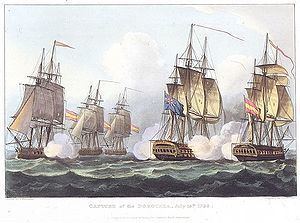Name HMS Lion Laid down May 1769 Construction started May 1769 Builder HMNB Portsmouth | Ordered 12 October 1768 Notes Sheer hulk from 1816 Launched 3 September 1777 | |
 | ||
Honours andawards Participated inBattle of Grenada Fate Sold for breaking up, 30 November 1837 | ||
Career
HMS Lion was a 64-gun third rate ship of the line of the Royal Navy, of the Worcester class, launched on 3 September 1777 at Portsmouth Dockyard.
Contents
She fought at the Battle of Grenada under Captain William Cornwallis on 6 July 1779, where she was badly damaged and forced to run downwind to Jamaica. She remained on the Jamaica station for the next year.
In March 1780, Lion fought an action in company with two other ships against a larger French force off Monte Christi on San Domingo. A second action took place in June 1780 near Bermuda when Cornwallis in Lion, with three other ships of the line and a fifty-gun ship, met a larger French squadron carrying the troops of Rochambeau to North America. The French were too strong for Cornwallis's squadron, but were content to continue with their mission instead of attacking the smaller British force.. Lion then returned to England, carrying with her Horatio Nelson, who was ill with malaria.
French Revolutionary Wars
In late July 1793, under the command of Captain Sir Erasmus Gower, Lion escorted the East Indiaman Hindostan, which carried the British ambassador Lord Macartney to the Bohai Gulf, off the Hai River, on his way to visit the Qianlong Emperor of China (the Macartney embassy). The ambassador and his party were conveyed up river by light craft to Tianjin before proceeding by land to Beijing On reaching Tianjin, Macartney sent orders to Lion to proceed to Japan, but because of sickness among the crew she was unable to do so. The embassy rejoined Lion at Canton in December 1793. The ship's journal from this voyage is in the library of Cornell University.
In 1796, she visited Cape Town; in 1797, her crew were among those who joined the Mutiny at the Nore. In 1798, now under the command of Sir Manley Dixon, Lion fought a squadron of Spanish frigates at the Action of 15 July 1798 and captured the Santa Dorotea.
She then took part in the siege of Malta, and with HMS Penelope and HMS Foudroyant captured the French 80-gun ship Guillaume Tell as she tried to escape from the blockade (Guillaume Tell was subsequently bought into the Royal Navy as HMS Malta).
In July 1807 in the Malacca Strait she successfully protected from the French frigate Semillante, without an engagement, a convoy homeward bound from China.
On 27 December 1807 Lion captured the French privateer lugger Reciprocité off Beachy Head. She was from Dieppe, had a crew of 45 men, and was armed with 14 guns. Lion sent her into the Downs.
In 1811, under the command of Captain Henry Heathcote, Lion was one of a large fleet of ships involved in the capture of Java from Dutch forces.
On 26 January 1812 Commander Henderson Bain of Harpy became acting captain of Lion. Bain returned to command of Harpy a few weeks before he received promotion to post captain 6 April 1813.
Lion was converted to a sheer hulk in September 1816, following the end of the Napoleonic wars.
Fate
Lion was sold to be broken up at Chatham on 30 November 1837.
